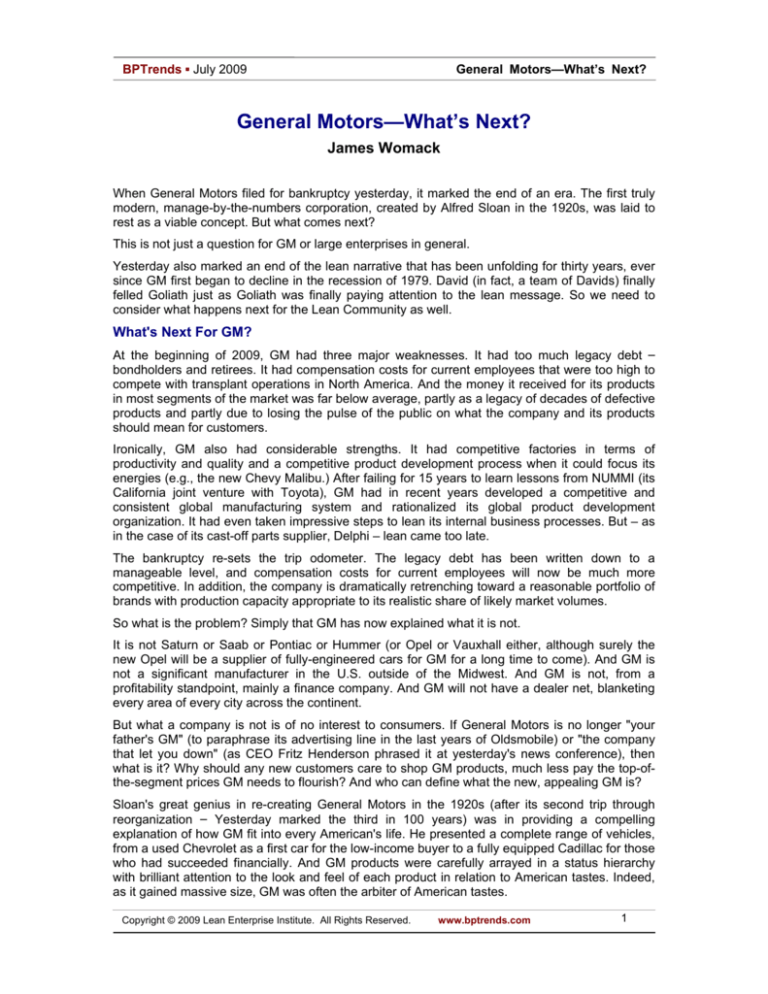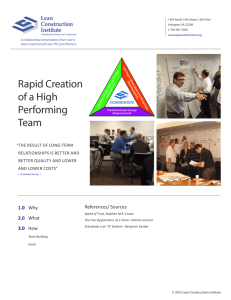
BPTrends ▪ July 2009
General Motors—What’s Next?
General Motors—What’s Next?
James Womack
When General Motors filed for bankruptcy yesterday, it marked the end of an era. The first truly
modern, manage-by-the-numbers corporation, created by Alfred Sloan in the 1920s, was laid to
rest as a viable concept. But what comes next?
This is not just a question for GM or large enterprises in general.
Yesterday also marked an end of the lean narrative that has been unfolding for thirty years, ever
since GM first began to decline in the recession of 1979. David (in fact, a team of Davids) finally
felled Goliath just as Goliath was finally paying attention to the lean message. So we need to
consider what happens next for the Lean Community as well.
What's Next For GM?
At the beginning of 2009, GM had three major weaknesses. It had too much legacy debt –
bondholders and retirees. It had compensation costs for current employees that were too high to
compete with transplant operations in North America. And the money it received for its products
in most segments of the market was far below average, partly as a legacy of decades of defective
products and partly due to losing the pulse of the public on what the company and its products
should mean for customers.
Ironically, GM also had considerable strengths. It had competitive factories in terms of
productivity and quality and a competitive product development process when it could focus its
energies (e.g., the new Chevy Malibu.) After failing for 15 years to learn lessons from NUMMI (its
California joint venture with Toyota), GM had in recent years developed a competitive and
consistent global manufacturing system and rationalized its global product development
organization. It had even taken impressive steps to lean its internal business processes. But – as
in the case of its cast-off parts supplier, Delphi – lean came too late.
The bankruptcy re-sets the trip odometer. The legacy debt has been written down to a
manageable level, and compensation costs for current employees will now be much more
competitive. In addition, the company is dramatically retrenching toward a reasonable portfolio of
brands with production capacity appropriate to its realistic share of likely market volumes.
So what is the problem? Simply that GM has now explained what it is not.
It is not Saturn or Saab or Pontiac or Hummer (or Opel or Vauxhall either, although surely the
new Opel will be a supplier of fully-engineered cars for GM for a long time to come). And GM is
not a significant manufacturer in the U.S. outside of the Midwest. And GM is not, from a
profitability standpoint, mainly a finance company. And GM will not have a dealer net, blanketing
every area of every city across the continent.
But what a company is not is of no interest to consumers. If General Motors is no longer "your
father's GM" (to paraphrase its advertising line in the last years of Oldsmobile) or "the company
that let you down" (as CEO Fritz Henderson phrased it at yesterday's news conference), then
what is it? Why should any new customers care to shop GM products, much less pay the top-ofthe-segment prices GM needs to flourish? And who can define what the new, appealing GM is?
Sloan's great genius in re-creating General Motors in the 1920s (after its second trip through
reorganization – Yesterday marked the third in 100 years) was in providing a compelling
explanation of how GM fit into every American's life. He presented a complete range of vehicles,
from a used Chevrolet as a first car for the low-income buyer to a fully equipped Cadillac for those
who had succeeded financially. And GM products were carefully arrayed in a status hierarchy
with brilliant attention to the look and feel of each product in relation to American tastes. Indeed,
as it gained massive size, GM was often the arbiter of American tastes.
Copyright © 2009 Lean Enterprise Institute. All Rights Reserved.
www.bptrends.com
1
BPTrends ▪ July 2009
General Motors—What’s Next?
So far, the only message about what GM is about is the Volt, its extended-range hybrid. Perhaps
this is a start, although with enormous risks, given the flux in technologies and in political and
public perceptions about climate change and energy dependency. But even if it is a start, it is a
very small start. Who can comprehensively define "your son's GM," "the GM that never lets you
down"? And what freedom will they have to do so?
It is easy to blame GM's recent management for its troubles. But the senior GM managers I have
known – almost all of whom had strong finance backgrounds – were remarkably competent at
running the company in the financially oriented, manage-by-results way that had produced
success for generations. So the problem is not the individual competence of managers but GM's
irrelevant conception of what management needs to do.
In simplest terms, where is the new Sloan, the leader able to rethink GM's management and
purpose and make it relevant to Americans again?
And supposing the new Sloan (or Sloans) can be found. What freedom will this person or team
have to run the company in a way that restores its former glory? This is truly a central question
because the U.S. government, as the new owner, is sure to be enormously conflicted:
Should the company be immediately and completely "right-sized" for its new place in the world?
(This would be the best way to boost share prices so the government can sell the stock to recoup
its massive investment. And it would be the best way to help Ford and Chrysler as well, by
eliminating excess capacity.) Or should GM stimulate employment in a deep recession and
placate the union by minimizing cutbacks? It can't do both.
Should GM focus in the next few years on the big pick-ups and SUVs that account for all of its
profits? (This would be another excellent way to boost share prices so the government can
recoup its investment.) Or should GM take a dramatic turn toward highly fuel-efficient products
that won't sell and certainly not at high margins unless energy pricing is also dramatically
adjusted upward toward world levels (e.g., $5 versus $2 per gallon)? It can't do both.
Clearly, the hard part comes now, after bankruptcy, and we will all watch what happens. But let
me make an exception for those readers – and there are many – who work at GM and who can
take an active role in making it happen. I truly wish you the best.
What's Next for Lean?
For 30 years now the Lean Community has benefited from a strong tail wind. GM steadily
declined as Toyota steadily advanced. All we needed to do was stand by and cheer! But that
narrative is over.
GM and almost all large manufacturers have now accepted lean as a management theory,
although the actual practice is always a struggle. As I noted above, GM was becoming a vastly
leaner enterprise just as it collapsed, and I have confidence that it will continue to embrace lean
principles and methods in the years immediately ahead.
At the same time, Toyota has turned out to have flaws of its own in the current financial crisis. It
barged ahead with capacity expansion across the world, outrunning its ability to create lean
managers and defying reasonable expectations for long-term market demand. (As I have
mentioned in previous e-letters, in the mid-1990s Toyota redefined its purpose from being the
best organization at solving customer problems to being the largest – an objective of no interest
to any customer.) This has been a real setback for the lean movement.
We in the Lean Community therefore find ourselves in the odd position of winning a battle of
ideas without actually getting most believers to fully practice their new convictions. And we have
as our ideal organization a company that is experiencing significant management and revenue
challenges despite "winning" the great contest between modern management and lean
management.
Copyright © 2009 Lean Enterprise Institute. All Rights Reserved.
www.bptrends.com
2
BPTrends ▪ July 2009
General Motors—What’s Next?
Even as this drama plays out within manufacturing, lean ideas are spreading rapidly to new fields,
from the beleaguered financial industry to healthcare to government services. Yet we have not
fully defined what lean means in these areas, much less how to implement and sustain it. So the
dramatic events of recent weeks do not make this a time for self-congratulation. Instead, it is a
time for modesty and self-reflection – hansei, if you will – as we all struggle with the economic
crisis while trying to re-define our own purpose as a Lean Community for the new era ahead.
_______
Author
James P. Womack is Founder and Chairman of the Lean Enterprise Institute, Inc.
Copyright © 2009 Lean Enterprise Institute. All Rights Reserved.
www.bptrends.com
3








